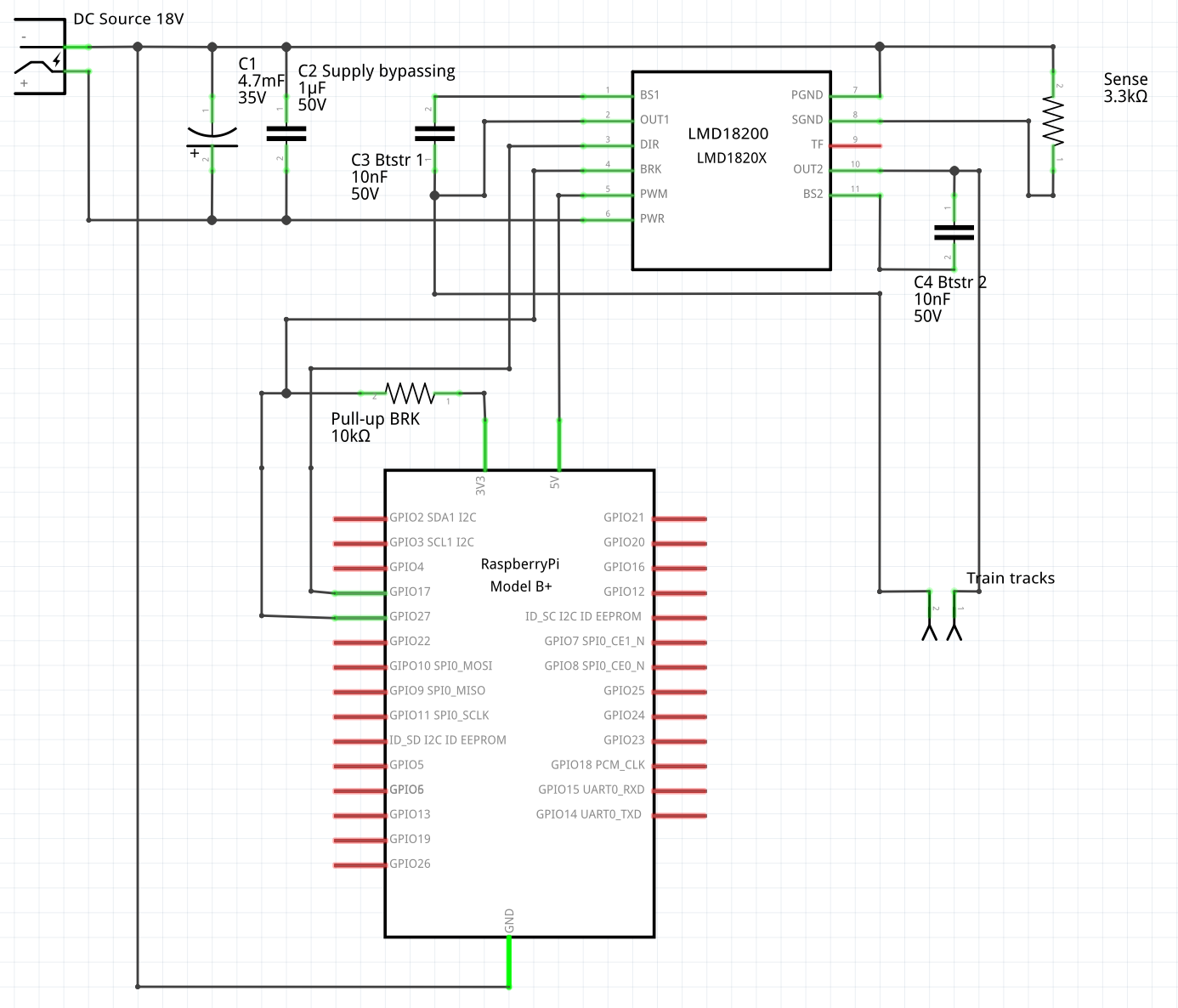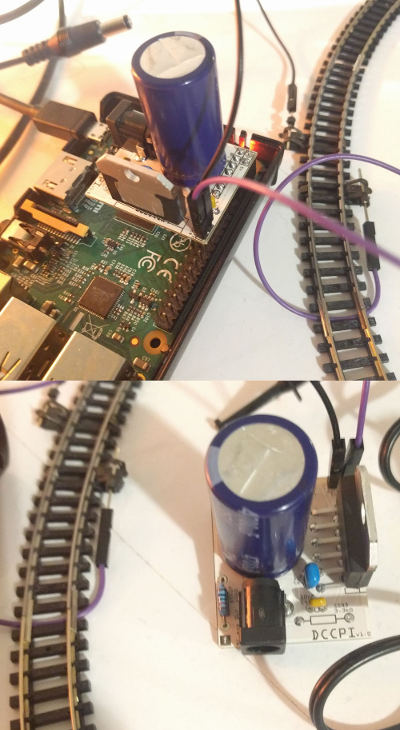NRMA Digital Command Control (DCC) implementation in Go.
This module implements the DCC protocol for controlling model trains.
It includes a Raspberry Pi driver and a dccpi command line application for easy use on this platform, although it is
easily extensible to other systems.
The implementation is based on the:
- S-91 Electrical Standard
- S-92 DCC Communications Standard
- S-9.2.1 Extended Packet Formats for Digital Command Control standard
- Features
- Hardware requirements
- Software requirements
- Installation
- Running
- Go library documentation
- License
You wanted a banana but what you got was a gorilla holding the banana and the entire jungle.
Joe Armstrong
go-dcc is aims to to provide a minimal feature set to control DCC-based locomotives. Although the original aim is to support Raspberry Pi as a Command Station, it can easily incorporate drivers for other platforms and be integrated in projects with larger scope. It is not a support-all, complex, multi-protocol, ui-included, buy-my-hardware solution. For this, there are better solutions like RocRail, JMRI, SPROG, GertBot etc.
go-dcc is inspired in dccpi(https://github.com/hsanjuan/dccpi), a Python library of similar characteristics. Go has the advantage that it requires no C dependencies, it is faster and less prone to errors. Some of the features supported are:
- Easy to build and install (using
go getor simply downloading the binaries) - Easy to adapt to new platforms
- Well tested and documented
- Supports Raspberry Pi Model B+ and newer
- Control DCC locomotives using a simple command line interface or Go
- Set speed (28 speed steps) and direction
- Set FL (lights), F1-F4 functions
Note go-dcc does not yet implement any advanced features like decoder registry operations (i.e. set address).
- A Raspberry Pi (developed/tested on model B+ v1.2). It should work with newer, more powerful models.
- DCC-decoder-equipped locomotives
- Train tracks
- Booster circuit: needed to provide the signal to the tracks. See below.
- A power adapter with ~12-24V DC output. I use an AC-DC adapter with an output of 18V, 2A.
go-dcc should work on any common scale. DCC decoders take a wide range of voltage outputs (up to 24v). This has been tested on N-scale with a 18v booster circuit.
Here is an example booster using LMD18200 H-Bridge from TI:
These are the parts:
- 1x 1µF Ceramic Capacitor 50Vdc ±20% , Multilayer
- 1x Electrolytic capacitor 4700 µF 35 V 20 %
- 2x 10nF Ceramic Capacitor 50Vdc % 5mm Holystone
- 1x DC Barrel Jack Adapter Breadboard Compatible
- 1x LMD18200T/NOPB Texas Instruments
- 1x10kΩ + 1x3.3kΩ resistors (both optional)
Here is an image of a dccpi printed PCB plugged to a Raspberry Pi:
- Go:
apt-get install golang-go
Simply run:
> go get -u github.com/stianeikeland/go-rpio
> go get -u github.com/hsanjuan/go-dccpi/dccpi
and the dccpi application will be downloaded, built and installed.
Building sources:
> go get -u github.com/hsanjuan/go-dccpi
> cd $GOPATH/src/github.com/hsanjuan/go-dccpi
> make
The Raspberry Pi driver is a submodule located at drivers/dccpi/dccpi.go.
By default, The Raspberry Pi will output the signal (which goes from 0v-Low to 3.3v-High) on BCM GPIO pin 17, which is Physical Pin 11 (Model B+). The booster is in charge of converting this signal into the DCC signal ranges (i.e. 18v to -18v).
The Raspberry Pi will also output a brake signal (HIGH) when the controller is stopped on BCM GPIO pin 27, which is Pysical Pin 13 (Model B+). This can be used to stop the signal on the tracks if your booster supports it (see booster schematics). Otherwise locos will receive DC current directly and probably turn into analog DC mode and start going at full speed.
The pins mentioned above are configurable.
The dccpi application allows to control locomotives and other DCC devices. Execute it and you will be taken to the dccpi console.
This is a summary of the available commands:
dccpi> help
Available commands (use "help <command>" for information):
direction - Control locomotive direction
fl - Control the headlight of a locomotive
exit - Exit from dccpi
help - Show this help
power - Control track power
speed - Control locomotive speed
status - Show information about devices
register - Add DCC device
unregister - Remove DCC device
save - Save current devices in configuration file
The dccpi application tries to read a JSON configuration file which specifies the configuration of the DCC decoders in the system. The configuration file default path is ~/.dccpi and looks like:
{
"locomotives": [
{
"name": "loco1",
"address": 6,
},
{
"name": "loco2",
"address": 7,
"fl": true
},
{
"name": "DCCThing",
"address": 8,
"f1": true,
"f2": true,
"f3": true,
"f4": false,
}
]
}This will allow to send packets to the three defined DCC devices directly without the need to register them when running the application.
The Go documentation is maintained with GoDoc. See: https://godoc.org/github.com/hsanjuan/go-dcc .
Additional drivers for go-dcc must implement the dcc.Driver interface.
PRs accepted. Please open an issue if you have any questions.
MIT. Copyright 2017 Hector Sanjuan. See LICENSE.

